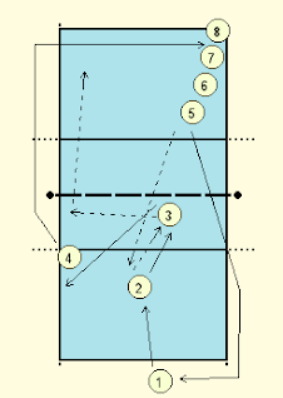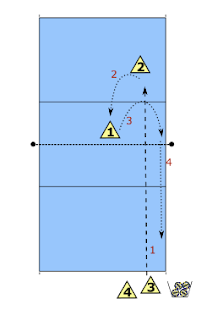Volleyball drills
- Invite parents
- Introduce
- Regels & agreements
- Expectations on both sides
- Matches & coaching
- Any announcements
Put the coordination ladder in the middle of the field.
Build up slowly, and players have to go as fast after each other as possible
through the ladder. But safe. If you see they follow each other too quickly, call the players yourself one by one.
Exercise 1
player 1 place both feet in one box but not at the same time, but 1 by 1.
So for example first left and right in box 1, and then left and right in box 2. And as fast as possible.
Exercise 2
Zigzag side-step
player 1 is standing next to the first box.
1 player puts right foot in the box and then left, then right foot out and left out.
2 then with left in box 2 followed by right
3. with left besides box 3, followed by right and then right in box 3 followed by left, and then right out the box again followed by left etc... until the end of the ladder
Exercise 3
In Out
player 1 puts the left foot in the first box and closes with right foot.
player 1 puts the left foot outside box 2 left of the box and right foot outside the 2nd box right of the box.
And back 1 by 1 in box 3, until the end of the ladder.
Hip rotation feet on the ground.
- Lying on your back with the arms spread to the side, knees bent and toes towards the shins.
- Let the knees fall to the left and hold for 2 seconds.
- Move back to the center line and let them fall to the right.
- Do this 5x per side
- Attention points
- Shoulders have to keep on the ground, knees together.
- pull in your navel and knees cannot touch the ground.
Hip rotation feet of the ground.
- Almost the same as last exercise but now the upper legs are in a right angle to the hip.
- And the knees in an angle of 90 degrees.
- Now, let fall 3x per side, but the knees still not touch the ground.
Scorpion:
- Lie on your stomach with the arms next to your body.
- Move your right foot to your left hand and reverse. 4x per side.
- stand up, and loosen up from top to bottom.
- Start with the neck to shoulder, arms, hips (already loosened up), knees and ankles.
Players divided over two sides (max 6 per side on the long side line)
- begin with easy running around own side. (side line -net line-side line-back line)
- after 3 rounds, the trainer is going to assign tasks.
- This is done on the net line and end line on the side line kids keep running.
1. closing step (sideways)
2. cross step (sideways)
3. knee lifting (forward)
4. Heels/buttocks.
5. Rotate right arm forward
6. Rotate left arm forward
7. Rotate right arm backwards
8. Rotate left arm backwards
9. take a sprint.
- Rebounding (per 2): wrist hit, correct foot forward, weaponing, hit the ball
- Kids bump with the ball on the ground to control afterwards and then hit the ball.
- FIRST (individually): hit downwards (wrist hit, correct foot forward, weaponing)
- THEN (individually): hit with wrist hit over the net
- THEN (per 2): hit with wrist hit over the net. The other kid defends this ball and hits back
- LAST (per 2): but then on points
- Per 2, each on one side of the field + a ball. Steps of attack run and then hit underneath the net ( 1 hand points to the ball, the other hand hits, wrist clamps around ball) other catches and does the same.
- Kids keep the balloon up and have to listen to the trainer. If the trainer claps 1x, the kids have to hit the balloon with the right hand (left foot forward, other hand is pointing). Clapping 2x hit left hand (right foot forward, other hand pointing)
- Kids are randomly walking over the field. When the trainer calls, they have to find a friend as fast as possible. They stand 4 steps away of each other, and calmly hit the balloon to each other (correct foot forward, pointing). This is how the kids change balloons. Balloon is caught overarm or underhand.
- Idem but with regular ball. They do not hit straight, but to the ground (wrist hit). Catch overarm
- Idem but pluck from the air and catch overarm
- Idem but pluck from the air, control, and throw back to the other (kids each have their own ball)
- Idem but with regular ball. They do not hit straight, but to the ground (wrist hit). Catch overarm
Game to conclude the training. This exercise combines the two nice concluding exercises King of Court and Smashball.
Played in pairs. In case of an even number of players, the pairs will remain the same, in case of an odd number two different team members are constantly in the field.
- One pair begins in the "king's field" and the other team at the other side of the field, the other players are waiting at the side for their turn.
- The team that begins on the other side of the field gets a ball served by the trainer, is played together three times to attack the "king's field"
- The rally is played until a point is scored.
- If the team on the other side scores a point, it takes the place of the team on the "king's field" and their place is taken by a new pair.
- If the team on the "king's field" scores a point, both pairs remain, and the team on the "king's field" is thrown a (hard) ball by the trainer which is defended and then the rally is finished.
- This offers an extra chance for the other team to get to the "king's field", while the team on the "king's field" can score an extra point.
- If the team on the "king's field" scores this point again, the other side changes team, and the service begins again.
This game seems a bit hard for the pupils at first, but the teams that have payed this game always want it as concluding game..
Attack on outside on two fields. Players pay attention to their run and arms. Then attack on the middle.

Player 1 is behind the end line and is reserve. Player 2 is in the middle of the field. Player 3 is on position 2-3. Player 4 is attacker left forward. Players 5-8 are in the other field left forward, all with a ball.
The first of the line (player 5 in this case) throws the ball to the middle of the other field. After throwing, he walks to the end line of the other field .
- Player 3 passes the ball to player 3 and follows his ball.
- Player 3 gives a set up to left forward position.
- Player 4 smashes the ball over the net, picks up the ball and join the back of the line.
- And it starts at the beginning. The next ball can be thrown when the set up has been given.
You have to score!

- For this exercise, the field is divided in two lengthwise
- Four persons on one side, four on the other side.
- 3 and 4 (1) serve.
- Player 2 passes the ball (2),
- player 1 gives a set up (3) and
- player 2 smashed the ball straight (4) so not diagonally.
- If 1 and 2 score together, they change spots, so 2 will be playmaker, and player 1 is going to pass and attack.
- if 1 and 3 DO NOT score, the attacker is going to serve, the playmaker is going to attack, and the server is going to be playmaker. The attacker is 'punished' because he did not score.
What is scoring here? Make clear agreements, for example a ball hit along the line.
- Trainer throws ball.
- Player has to bounce the ball on the upper leg.
- Pay attention: the foot of the leg on which the ball bounces, has to be on the ground!
Set up net and stretch
BAL ROLLEN EN STOPPEN
- Line 1 players ready to stop ball
- Line 2 players behind trainer with ball
- Front player puts ball in hands trainer and joins line 1
- Trainer rolls ball and player from line 1:
- Stops ball with right hand
- Stops ball with left hand
- Stops the ball with the foot
- Runs around and sist in front of the ball, and lest ball roll between the legs
- Runs around and lies down in front of the ball and holds the ball still with stretched arms
- High tempo!
Stomach muscle exercises:
20 x up, 20 x up, hold, 10 x up in 3 steps, 10 x up in 7 steps
10 x squats, 10 x burpies, planking, push ups
Practice fanatically
Rally pass, underhand and overarm
| In the matches, these are the balls which are easily played over the net by the opponent. It is important to optimally use the chances offered. The pass has to be perfect and to achieve that requires a lot of practice. The warming up is very suited for this. The adjacent drawing is divided in 3 phases, A, B, and C, but all are about the same pair. At A, 1 has the ball and 2 is at the 3 meter line. 1 plays the ball (1) with an arch in the back field, and 3 moves to the back. At B, 2 has arrived in the back field and plays the ball (2) back to 1, who is still at the net, and walks back to the 3 meter line. 1 plays the ball (3) again to the 3 meter line, in such a way that 2 can get under it At C, 2 plays the ball (4) back to 1 again and moves to the back again, and plays the ball (5) in the back field again. Pay attention that players always get behind the ball and that they are in balance when playing the ball. In the back field, the trajectory of the pass player 2 plays can be flatter, so the ball is a bit faster at 1. The short ball needs to be high, so the playmaker (in the match) has the time to get under the ball and deliver the perfect set up to score the point. You can do the exercise overarm or underhand. In both exercises, you have to play overarm at the net. Demand all balls to be perfect! These are the chances offered and you have to seize them When passing overarm, pay attention to:
|
Set up net
Run rounds around the hall and stretch
ROLL BALL AND STOP
- Line 1 players ready to stop ball
- Line 2 players behind trainer with ball
- Front player puts ball in hands trainer and joins line 1
- Trainer rolls ball and player from line 1:
- Stops ball with right hand
- Stops ball with left hand
- Stops the ball with the foot
- Runs around and sits in front of the ball, and lest ball roll between the legs
- Runs around and lies down in front of the ball and holds the ball still with stretched arms
- High tempo!
Stomach muscle exercises:
20 x up, 20 x up, hold, 10 x up in 3 steps, 5 x up in 7 steps
10 x squats, 10 x burpies, planking, push ups








